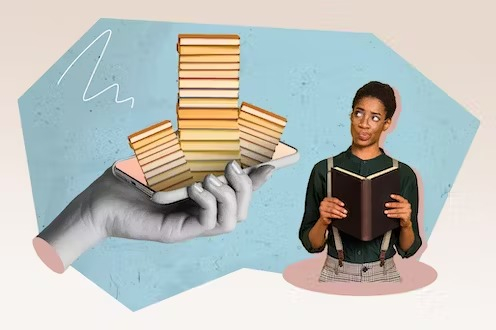If you’ve been in a bookshop recently, you may have seen references to BookTok – whether it’s stickers on books or whole tables dedicated to “BookTok favourites”.
BookTok is a community on the social media app TikTok. Creators make short videos recommending, reviewing, or just generally chatting about books. This community has become one of the biggest on the platform and its hashtag (#BookTok) has been used on over 60 billion videos. BookTok’s influence over the publishing industry and what young people are reading is staggering.
Online reading communities have been around for a while. Goodreads – a social cataloguing platform where readers can follow friends and authors, get book recommendations and read user-submitted reviews – was launched in 2007, and there are other communities on sites such as YouTube (BookTube) and Instagram (Bookstagram).
However, none of these sites seem to have captured the attention of readers, publishers and retailers quite like BookTok. Caroline Hardman, a literary agent at Hardman & Swainson, corroborates this, telling The Guardian: “It’s having a strong effect on what publishers look for.”
Is BookTok’s impact positive or negative?
The main demographic of BookTok creators, viewers and authors is young women. While books popular with young women have gained immense broad popularity before – for example, the Twilight saga (from 2005) by Stephenie Meyer, and the paranormal romance fever that followed – young women have rarely been taken seriously as either critics and readers.
But times are changing. The books most popular with BookTok – such as romance, fantasy and the hybrid genre “romantasy” – are being picked up more and more by publishers and displayed more prominently in bookshops.
Book series such as A Court of Thorns and Roses by Sarah J Maas (from 2015) are immensely popular on BookTok – with some videos about the series amassing over a million views. The series is marketed alongside new releases like The Hurricane Wars by Thea Guanzon or A Touch of Chaos by Scarlett St. Clair, with Maas’s series appearing as “similar” or “recommended” on Amazon, Waterstones and Goodreads, as well as often being mentioned in readers’ reviews.

Young women are shaping publishing like never before. Ground Picture/Shutterstock
Mythology retellings are also immensely popular on BookTok, sparked by titles such as The Song of Achilles by Madeline Miller (2011). Such titles now heavily feature on publishers’ new release and coming soon lists.
While it is fascinating to see that young women and their tastes can have such a big impact on the publishing industry, there’s a risk it may homogenise the industry. Literary critic Barry Pierce has said that BookTok reads “all sort of have the same cover”. Meanwhile author Stephanie Danler said of her foray into BookTok: “It seemed impossible to discover different fiction. It was the same 20 books over and over.”
BookTok also has a problem with diversity – in more ways than one. Its recommendations are overwhelmingly by white authors, and it is unclear what the long-term effects of this will be on both publishing and the young readers who flock to the app for recommendations. Furthermore, by catering to this huge audience of young women, publishers are forgoing books by men, especially emerging writers.
Reviving books and identifying as ‘readers’
BookTok is also proving a powerful tool for renewing interest in past titles. At the inaugural BookTok Awards held in August, Dolly Alderton’s memoir Everything I Know About Love won in the “best book to end a reading slump” category, despite being published in 2018.
These awards even had a “best BookTok revival” category, with the award going to Jane Austen’s Pride and Prejudice (1813). It’s funny to think that Austen, an author so revered that is she is printed on the £10 note, is being “revived”, but the younger demographic of BookTok may mean that new audiences are coming to even such established authors.
Tiktok Book Awards Book Of The Year, voted for by readers 🥹🍯🌶🤍 so grateful. I actually didn't think I would win I was sipping my marg minding my business lol. Romance is such a derided genre and it means so much for me and Kiki to be seen and held! pic.twitter.com/t0e62YQqyD
— Bolu Babalola is technically on leave 🍯&🌶 (@BeeBabs) August 17, 2023
It also makes startlingly clear how much BookTok and its creators are tastemakers who are shaping what and how young people read. As some creators themselves have said, BookTok favours “convincing you to read books based on their aesthetics”.
This might appear a shallow way to read but it is clearly very compelling, especially for a generation for whom countercultures have given way to microtrends and niche aesthetic identities. Young people are no longer punks, hippies or goths, but instead dress with a “cottagecore” or “dark academia” aesthetic.
Identity and aesthetics are potent tools that BookTok utilises to drive views, enthusiasm and sales – even if the latter isn’t the creators’ explicit aim. BookTok encourages people to identify as “readers” rather than simply to read – indeed, to identify as specific kinds of reader such as “romance readers” or “fantasy readers”.
The constant supply of new content, book releases and ways to show yourself to be a reader – all displayed in visually compelling snippets – means that BookTok’s impact on what young people are reading is uniquely powerful.



 Arthur Hayes Drives Solana Meme Coin Rally, FlowerAI’s Market Cap Jumps $8M After Social Media Post
Arthur Hayes Drives Solana Meme Coin Rally, FlowerAI’s Market Cap Jumps $8M After Social Media Post  Bitcoin Slides to $95K, XRP Falls Over 10% Amid $495M Liquidation Wave Impacting 197K Traders
Bitcoin Slides to $95K, XRP Falls Over 10% Amid $495M Liquidation Wave Impacting 197K Traders  Ether Price Rises Despite $1.3B Whale Sell-Off, Targets $3,700 Breakout
Ether Price Rises Despite $1.3B Whale Sell-Off, Targets $3,700 Breakout  China's Hackers Poised for Conflict Within US Networks, Cyber Official Warns
China's Hackers Poised for Conflict Within US Networks, Cyber Official Warns  XRP Soars as Trump’s Pro-Crypto Treasury Pick Gains Ripple CEO’s Approval
XRP Soars as Trump’s Pro-Crypto Treasury Pick Gains Ripple CEO’s Approval  Solana Hits $262 ATH Amid $35M Whale Buys—Could $5,000 Be Next?
Solana Hits $262 ATH Amid $35M Whale Buys—Could $5,000 Be Next?  Siri's AI Upgrade in iOS 19 May Signal Apple's Split from OpenAI and ChatGPT
Siri's AI Upgrade in iOS 19 May Signal Apple's Split from OpenAI and ChatGPT  Shiba Inu’s Kusama Strikes Back at Critics, Declares 'Send SHIB to the Moon' Mission Is on Track
Shiba Inu’s Kusama Strikes Back at Critics, Declares 'Send SHIB to the Moon' Mission Is on Track  Dogecoin Rockets 25% as Analyst Forecasts Bullish Breakout to $0.82
Dogecoin Rockets 25% as Analyst Forecasts Bullish Breakout to $0.82  Shiba Inu Sends Urgent Scam Alert Amid 12% Price Spike: Details Unveiled
Shiba Inu Sends Urgent Scam Alert Amid 12% Price Spike: Details Unveiled  What’s Driving Charles Schwab Toward Spot Crypto Trading? Trump’s Regulatory Shift and $100K Bitcoin Answer
What’s Driving Charles Schwab Toward Spot Crypto Trading? Trump’s Regulatory Shift and $100K Bitcoin Answer  $18 XRP Prediction Gains Traction as Wave 3 Builds Toward $5 Surge Before 2024
$18 XRP Prediction Gains Traction as Wave 3 Builds Toward $5 Surge Before 2024  Shiba Inu Burn Rate Explodes 49,646% as SHIB Price Climbs 10% in Stunning Market Rally
Shiba Inu Burn Rate Explodes 49,646% as SHIB Price Climbs 10% in Stunning Market Rally  Crypto Rules Shakeup: Trump-Tied SEC Candidate Hints at Clearer Path After Gensler’s Sudden Exit
Crypto Rules Shakeup: Trump-Tied SEC Candidate Hints at Clearer Path After Gensler’s Sudden Exit  OpenAI, Samsung Talks Signal a Major Shift for Galaxy Devices, Threatening Google’s AI Stronghold
OpenAI, Samsung Talks Signal a Major Shift for Galaxy Devices, Threatening Google’s AI Stronghold  Texas Considers Bitcoin Reserve Legislation Amid Push for US Crypto Mining Security
Texas Considers Bitcoin Reserve Legislation Amid Push for US Crypto Mining Security  Nvidia CEO: Trump’s AI Export Limits Won’t Halt Global Tech Collaboration
Nvidia CEO: Trump’s AI Export Limits Won’t Halt Global Tech Collaboration 
































